
Before you hit the road with a conventional travel trailer or a fifth-wheel, it’s important to understand towing capacity, weight ratings, equipment needs, and more. That’s true for new RVers, of course, but it also applies to motorhome owners planning to make the switch to a towable RV. Even people with experience towing an RV sometimes need a quick refresher. This primer focuses on towing travel trailers and fifth-wheels. It covers the basics, including terminology and equipment, as well as tips and a checklist to help ensure a good towing experience. We also encourage you to ask questions of seasoned RV enthusiasts, attend seminars and conventions, and participate in towing workshops. All can pay huge dividends.

Glossary
Gross vehicle weight rating (GVWR):
The maximum allowable weight of a fully loaded vehicle, including cargo, fluids, passengers, and the tongue weight (see definition below) of a towed vehicle. The manufacturers of the towing vehicle and the towable RV establish the respective GVWRs.
Gross vehicle weight (GVW):
The weight of a towing vehicle (truck, SUV, car) or a towable RV when fully loaded, including cargo, fluids, and passengers. GVW can be determined by individually weighing a loaded towing vehicle and a loaded towable RV at a truck scale. GVW must not exceed the GVWR.
Rated towing capacity:
The maximum weight that a towing vehicle can tow, as established by the vehicle’s manufacturer. The capacity is based on factors such as engine displacement; horsepower and torque; engine type (diesel or gasoline); braking system; engine and transmission cooling system; axle ratio; whether the vehicle is two-wheel or four-wheel drive; suspension system; and chassis strength.
Gross combination weight rating (GCWR):
The maximum allowable combined weight of a towing vehicle and a towable RV, as determined by the manufacturer of the towing vehicle.
Tongue weight:
The downward load (in pounds) that the coupler on the trailer tongue exerts on the hitch ball at the rear of the towing vehicle. On a fifth-wheel, this is the weight the RV exerts on the fifth-wheel hitch or gooseneck hitch in the pickup truck bed. Generally, the tongue weight is 10 percent to 15 percent of the travel trailer’s gross vehicle weight. For a fifth-wheel, the tongue weight typically is 15 percent to 25 percent of the RV’s gross vehicle weight. The percentages should be verified with the towing vehicle’s manufacturer and the travel trailer/fifth-wheel’s manufacturer.
Trailer tongue/fifth-wheel hitch pin weight ratings:
The maximum allowable tongue weight a travel trailer can place on the ball hitch at the rear of a towing vehicle, or the maximum amount of weight allowed on the head of a fifth-wheel hitch or gooseneck hitch in the bed of a truck. The towing vehicle manufacturer sets these ratings.
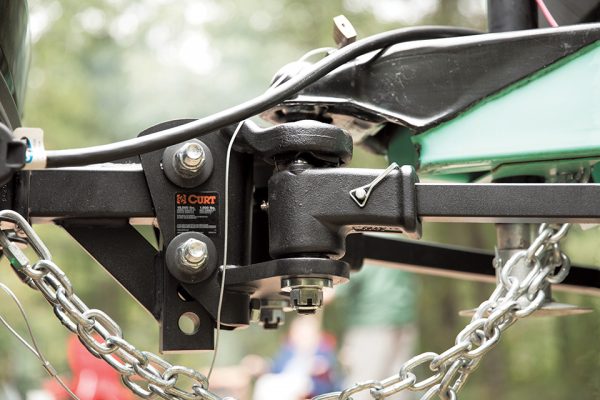
Gross axle weight rating (GAWR):
The maximum allowable weight each axle on a towing vehicle and on a towable RV is designed to carry, as determined by the vehicle manufacturer. To verify that the GAWR is not exceeded, visit a truck scale and weigh each axle of the fully loaded towing vehicle and towable RV at the wheels.
Curb weight:
The weight of a towing vehicle (without passengers and cargo), as determined by the manufacturer. This may include a full fuel tank (verify with the manufacturer). The base curb weight for a travel trailer or fifth-wheel, as determined by the manufacturer, is the weight of the RV with empty holding tanks and no cargo or passengers.
Payload capacity:
The maximum weight (cargo) a towing vehicle or a towable RV is designed to carry. This is the GVWR minus the curb weight.
Towing Equipment
Trailer brakes:
The RV manufacturer installs these, and they can be electric, electric/hydraulic, or hydraulic/surge brakes.
Brake controller:
An electronic device installed on the dash, within easy reach of the driver, which works in conjunction with the vehicle’s foot brake pedal to stop the trailer. It can be adjusted to provide more or less braking force. A manual lever on the brake controller permits the driver to apply the electric brakes on the towable trailer independent of the foot brake pedal. It can be installed as original equipment or via the aftermarket.

Breakaway system:
A device that works with the trailer brakes to prevent damage and injury in the event the trailer becomes disconnected from the towing vehicle during travel. The system includes a battery, a breakaway switch, and an optional charger. The battery must be fully charged before use.
Receiver hitch (travel trailers):
The hitch mounted at the rear of the towing vehicle. Hitches are rated in five classes, and typically these are the weights: Class I is rated to tow up to 2,000 pounds; Class II, up to 3,500 pounds; Class III, up to 8,000 pounds; Class IV, up to 10,000 pounds; Class V, up to 20,000 pounds. Each individual hitch has specific weight ratings that may or may not reach the maximum range for that class of hitch. The hitch ball mount is inserted into a square opening (the receiver). Receiver sizes (in inches) are 1¼ by 1¼; 2 by 2; 2½ by 2½; and 3 by 3. Be sure the receiver hitch and all hitch accessories (hitch ball, ball mount, safety chains, and weight distribution hitch) are rated to meet or exceed the weight of the towed trailer.
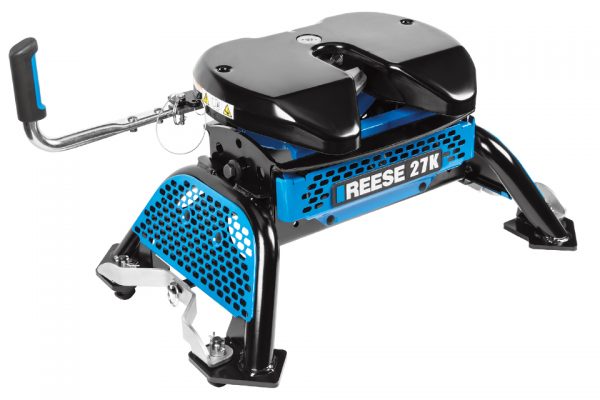
Fifth-wheel and gooseneck hitches:
Types of hitches that are mounted in the pickup truck bed. When a gooseneck hitch, which resembles a ball mount, is not connected to a trailer, cargo can be hauled in the truck bed. A fifth-wheel hitch, which includes a large, flat plate that resembles a horseshoe, takes up a large amount of space in the truck bed.
Hitch ball:
A ball that allows the trailer to swivel. It attaches to the ball mount that slips into the square receiver of the towing vehicle. The travel trailer tongue coupler fits over the hitch ball. The coupler locks around the ball insert. Common ball diameters are 1 7/8 inches; 2 inches; and 2 5/16 inches. Each size is rated to accommodate differing trailer weights.
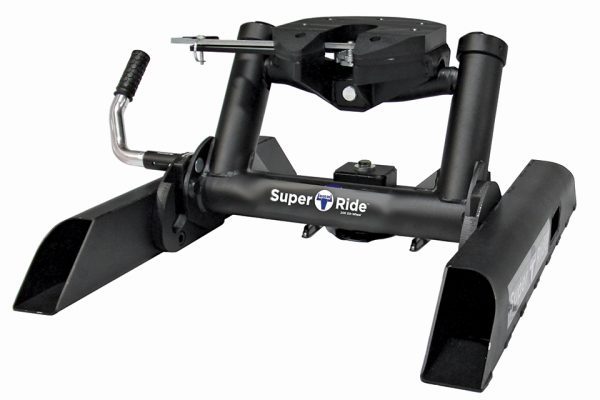
Adjustable ball mount:
The hitch ball is bolted to this mount, which can be adjusted to lower or raise the height of the ball so as to level the trailer tongue and towable chassis when hitched.
Coupler:
A device on the end of the trailer tongue that locks around the hitch ball. It must be the same size as the hitch ball and rated for the GVWR of the trailer.
Safety chains:
A means of keeping a trailer attached to the towing vehicle should the hitch or hitch ball become disconnected. The chains must be crossed below the ball with enough slack in them to allow the towing vehicle and travel trailer to maneuver independently while turning.
Sway control device:
A bar that attaches to the towing vehicle and the trailer at the coupling point in order to counteract lateral movement of the trailer.
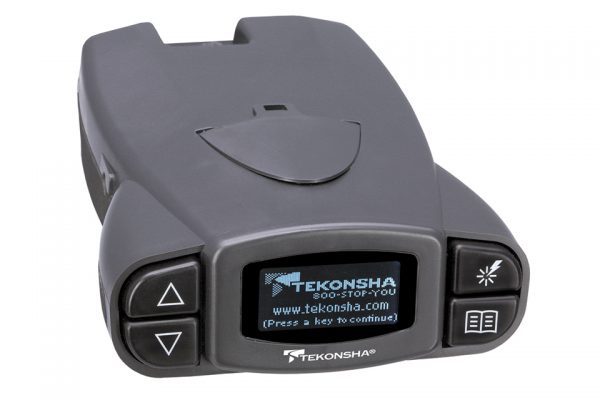
Weight distribution hitch:
A means of reducing trailer sway by distributing weight evenly between the towing vehicle axles and the travel trailer axles. Some weight distribution hitches come with a built-in or add-on sway control system. A weight distribution hitch also can improve vehicle braking and steering.
Electrical connectors/plug:
The means of connecting the towing vehicle’s electrical system to the trailer, including its stop, tail, and turn lights. Depending on the number of pins in the connector (four to seven), you may also have functionality for backup lights, electric trailer brakes, and a 12-volt circuit. Each pin allows the towing vehicle and trailer’s electrical system to work together.
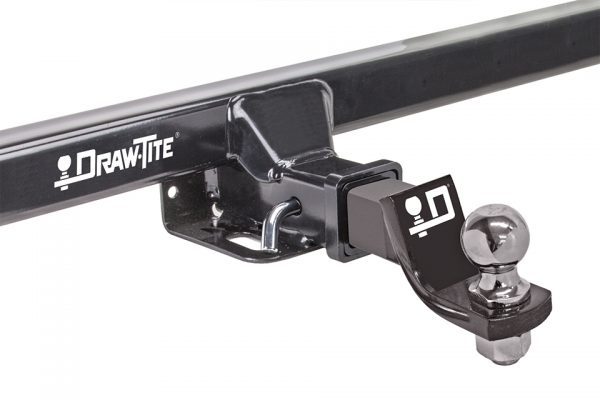
Loading
A travel trailer or fifth-wheel should be loaded so the weight is balanced. The rule of thumb is to place 60 percent of the cargo weight forward of the RV’s front axle, with the weight distributed evenly from side to side. Do not exceed the GAWR. Use straps and/or tie-downs to secure the cargo while in transit.
Pretrip Checklist
*Identify the towing component with the lowest weight rating on both the towing vehicle and on the towable RV, and do not exceed that rating. For example, if the receiver hitch is rated for 5,000 pounds, and the hitch ball is rated for 3,500 pounds, then the maximum weight that can be towed is 3,500 pounds.
*Install safety chains.
*Install breakaway devices.
*Place safety and locking pins on the receiver hitch and the coupler.
*Verify that all RV lights work properly. Adjust the brake controller as required.
*Check the tires for wear and proper inflation.
*Check the torque of the lug nuts on the towable RV.
*Do a walk-around inspection of both the towing vehicle and the RV.
*Verify that cargo in the RV is secure and properly distributed.

Towing Tips
*Find a large, empty parking lot to practice hitching, unhitching, and backing up. Use wheel chocks to prevent the towable RV from rolling away when it’s unhooked from the towing vehicle.
*Make wide turns to accommodate the added length of the travel trailer or fifth-wheel.
*Remember that when you are towing an RV, acceleration of the towing vehicle is slower and the distance needed to come to a stop is greater. This also underscores the importance of verifying that your towing vehicle has the horsepower, torque, and suspension needed to tow the fifth-wheel or travel trailer of your choice.
*Before departing, know what road conditions to expect.
*Call ahead to the RV campground where you will be staying and ask for a pull-through spot or one sufficiently large enough to allow you to position your RV at your campsite.
*Adjust the side mirrors.
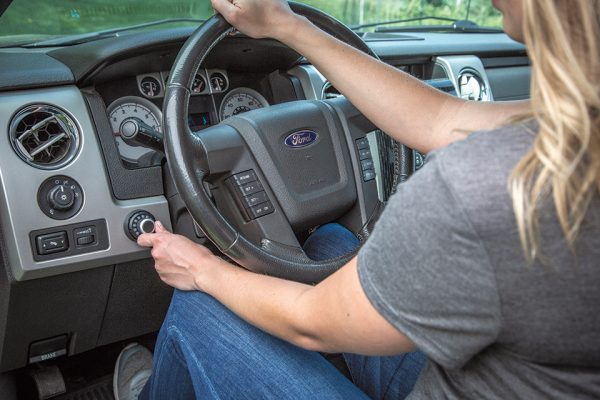
NHTSA, AAA Publications
*The National Highway Transportation Safety Administration publishes “Towing A Trailer: Being Equipped For Safety.” It covers hitch systems, towing packages, tires, driving permits, and more.
*AAA’s Digest of Motor Laws includes trailer speed limits for each U.S. state and Canadian province.
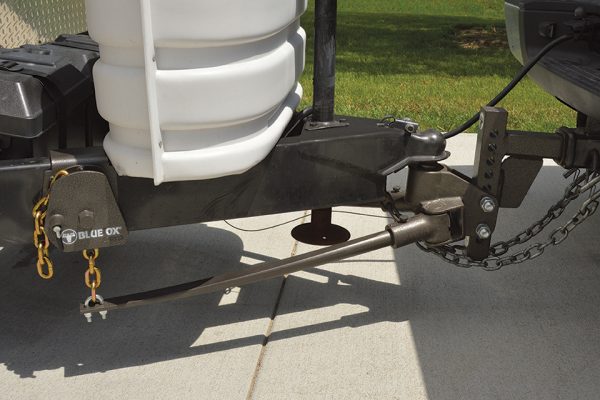
Resources
A sampling of manufacturers that offer towing products for travel trailers and fifth-wheels:
*FMCA commercial member
Blue Ox, C2903* Fifth-wheel and gooseneck hitches; accessories; weight distribution hitches.
Curt Manufacturing Fifth-wheel and gooseneck hitches; weight distribution hitches; sway controls; brake controls; cargo management; electrical products; accessories.
Demco, C2262* Fifth-wheel hitches; frame bracket kits; brake components.
Eaz-Lift (Camco Manufacturing, C3071*) Fifth-wheel and gooseneck hitches; weight distribution hitches; sway controls; stabilization products; balls and shanks; electrical components; accessories.
Hensley Manufacturing Inc. Fifth-wheel hitches, antisway hitches; accessories.
Horizon Global (includes Draw-Tite, Reese, and Tekonsha) Fifth-wheel hitches; gooseneck hitches; jacks; weight distribution hitches; ball mounts; hitch balls; brake controls; cables; couplers; breakaway systems; electrical components; connectors; locks; lighting; sway controls; accessories.
Husky Towing Products Fifth-wheel hitches; gooseneck hitches; weight distribution/sway control hitches; ball mounts; brake controls; jacks; electrical products; lights; stabilizers; accessories.
Roadmaster Inc., C2952* Comfort Ride suspension system; tongue jack extension.
Written By Lazelle Jones. This article originally appeared in Family RVing Magazine in October 2019.


Leave a Reply